Lean Management at Toyota: Process Evaluation, Target & Implementation
VerifiedAdded on 2023/04/23
|23
|6757
|339
Report
AI Summary
This report provides an in-depth analysis of lean management principles as applied by Toyota, a leading global automobile manufacturer. It begins by rehearsing the core tenets of lean management, emphasizing waste reduction and value creation. The report then critically evaluates Toyota's processes, examining how the five key lean principles—defining value, mapping the value stream, creating flow, establishing pull, and pursuing perfection—are implemented. It discusses the benefits and challenges of each principle, considering factors such as customer needs, waste elimination, and continuous improvement. Furthermore, the report develops a target process for Toyota, outlining specific steps for enhancing efficiency and effectiveness. An implementation plan is proposed, detailing strategies for integrating the target process into Toyota's operations. Finally, the report suggests methods for instituting continuous improvement within the organization, fostering a culture of ongoing learning and adaptation. Desklib offers a range of study tools and solved assignments to support students' academic endeavors.

Running head: MANAGEMENT
Management
Name of the Student
Name of the University
Author note
Management
Name of the Student
Name of the University
Author note
Paraphrase This Document
Need a fresh take? Get an instant paraphrase of this document with our AI Paraphraser
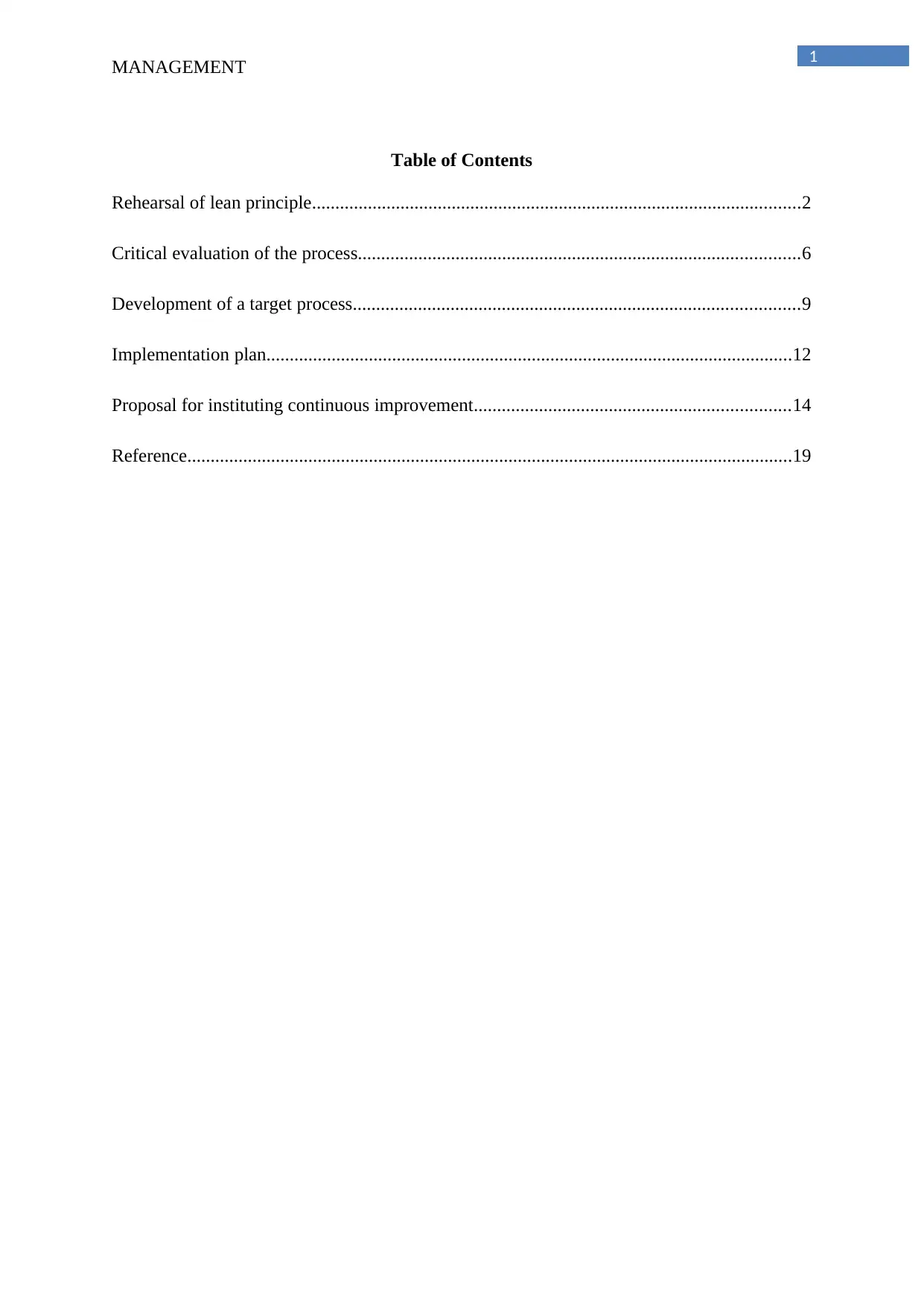
1
MANAGEMENT
Table of Contents
Rehearsal of lean principle.........................................................................................................2
Critical evaluation of the process...............................................................................................6
Development of a target process................................................................................................9
Implementation plan.................................................................................................................12
Proposal for instituting continuous improvement....................................................................14
Reference..................................................................................................................................19
MANAGEMENT
Table of Contents
Rehearsal of lean principle.........................................................................................................2
Critical evaluation of the process...............................................................................................6
Development of a target process................................................................................................9
Implementation plan.................................................................................................................12
Proposal for instituting continuous improvement....................................................................14
Reference..................................................................................................................................19
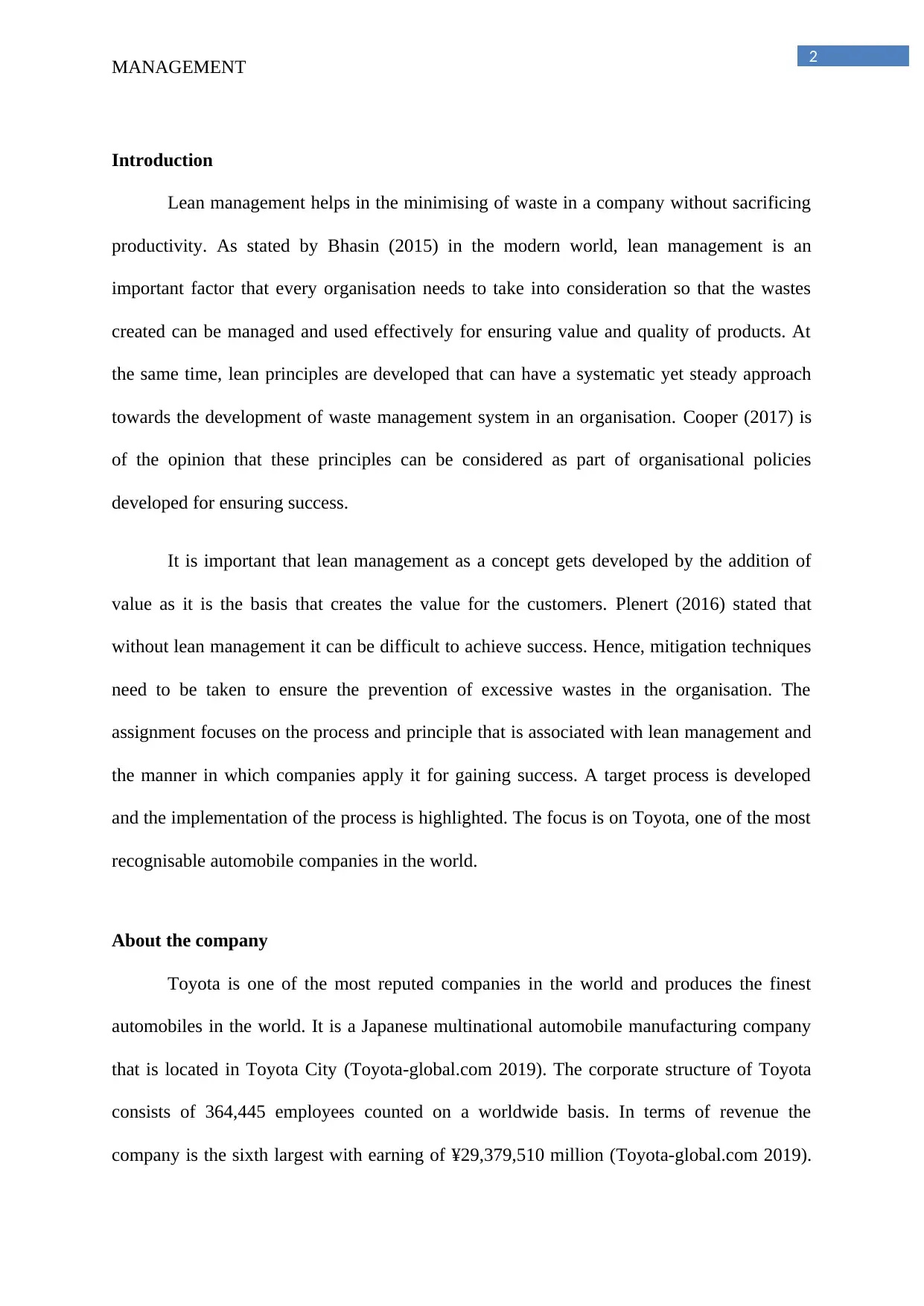
2
MANAGEMENT
Introduction
Lean management helps in the minimising of waste in a company without sacrificing
productivity. As stated by Bhasin (2015) in the modern world, lean management is an
important factor that every organisation needs to take into consideration so that the wastes
created can be managed and used effectively for ensuring value and quality of products. At
the same time, lean principles are developed that can have a systematic yet steady approach
towards the development of waste management system in an organisation. Cooper (2017) is
of the opinion that these principles can be considered as part of organisational policies
developed for ensuring success.
It is important that lean management as a concept gets developed by the addition of
value as it is the basis that creates the value for the customers. Plenert (2016) stated that
without lean management it can be difficult to achieve success. Hence, mitigation techniques
need to be taken to ensure the prevention of excessive wastes in the organisation. The
assignment focuses on the process and principle that is associated with lean management and
the manner in which companies apply it for gaining success. A target process is developed
and the implementation of the process is highlighted. The focus is on Toyota, one of the most
recognisable automobile companies in the world.
About the company
Toyota is one of the most reputed companies in the world and produces the finest
automobiles in the world. It is a Japanese multinational automobile manufacturing company
that is located in Toyota City (Toyota-global.com 2019). The corporate structure of Toyota
consists of 364,445 employees counted on a worldwide basis. In terms of revenue the
company is the sixth largest with earning of ¥29,379,510 million (Toyota-global.com 2019).
MANAGEMENT
Introduction
Lean management helps in the minimising of waste in a company without sacrificing
productivity. As stated by Bhasin (2015) in the modern world, lean management is an
important factor that every organisation needs to take into consideration so that the wastes
created can be managed and used effectively for ensuring value and quality of products. At
the same time, lean principles are developed that can have a systematic yet steady approach
towards the development of waste management system in an organisation. Cooper (2017) is
of the opinion that these principles can be considered as part of organisational policies
developed for ensuring success.
It is important that lean management as a concept gets developed by the addition of
value as it is the basis that creates the value for the customers. Plenert (2016) stated that
without lean management it can be difficult to achieve success. Hence, mitigation techniques
need to be taken to ensure the prevention of excessive wastes in the organisation. The
assignment focuses on the process and principle that is associated with lean management and
the manner in which companies apply it for gaining success. A target process is developed
and the implementation of the process is highlighted. The focus is on Toyota, one of the most
recognisable automobile companies in the world.
About the company
Toyota is one of the most reputed companies in the world and produces the finest
automobiles in the world. It is a Japanese multinational automobile manufacturing company
that is located in Toyota City (Toyota-global.com 2019). The corporate structure of Toyota
consists of 364,445 employees counted on a worldwide basis. In terms of revenue the
company is the sixth largest with earning of ¥29,379,510 million (Toyota-global.com 2019).
⊘ This is a preview!⊘
Do you want full access?
Subscribe today to unlock all pages.

Trusted by 1+ million students worldwide
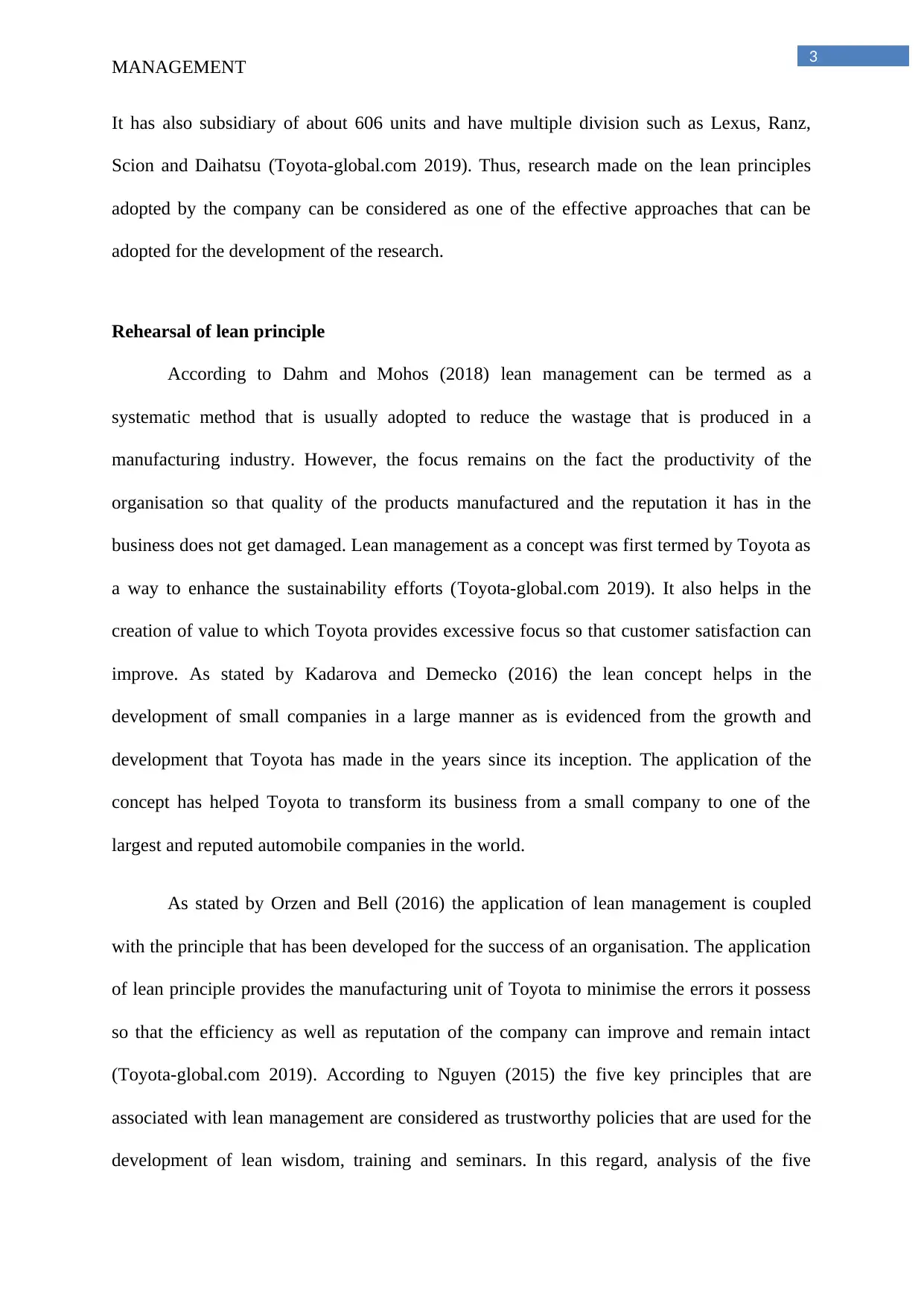
3
MANAGEMENT
It has also subsidiary of about 606 units and have multiple division such as Lexus, Ranz,
Scion and Daihatsu (Toyota-global.com 2019). Thus, research made on the lean principles
adopted by the company can be considered as one of the effective approaches that can be
adopted for the development of the research.
Rehearsal of lean principle
According to Dahm and Mohos (2018) lean management can be termed as a
systematic method that is usually adopted to reduce the wastage that is produced in a
manufacturing industry. However, the focus remains on the fact the productivity of the
organisation so that quality of the products manufactured and the reputation it has in the
business does not get damaged. Lean management as a concept was first termed by Toyota as
a way to enhance the sustainability efforts (Toyota-global.com 2019). It also helps in the
creation of value to which Toyota provides excessive focus so that customer satisfaction can
improve. As stated by Kadarova and Demecko (2016) the lean concept helps in the
development of small companies in a large manner as is evidenced from the growth and
development that Toyota has made in the years since its inception. The application of the
concept has helped Toyota to transform its business from a small company to one of the
largest and reputed automobile companies in the world.
As stated by Orzen and Bell (2016) the application of lean management is coupled
with the principle that has been developed for the success of an organisation. The application
of lean principle provides the manufacturing unit of Toyota to minimise the errors it possess
so that the efficiency as well as reputation of the company can improve and remain intact
(Toyota-global.com 2019). According to Nguyen (2015) the five key principles that are
associated with lean management are considered as trustworthy policies that are used for the
development of lean wisdom, training and seminars. In this regard, analysis of the five
MANAGEMENT
It has also subsidiary of about 606 units and have multiple division such as Lexus, Ranz,
Scion and Daihatsu (Toyota-global.com 2019). Thus, research made on the lean principles
adopted by the company can be considered as one of the effective approaches that can be
adopted for the development of the research.
Rehearsal of lean principle
According to Dahm and Mohos (2018) lean management can be termed as a
systematic method that is usually adopted to reduce the wastage that is produced in a
manufacturing industry. However, the focus remains on the fact the productivity of the
organisation so that quality of the products manufactured and the reputation it has in the
business does not get damaged. Lean management as a concept was first termed by Toyota as
a way to enhance the sustainability efforts (Toyota-global.com 2019). It also helps in the
creation of value to which Toyota provides excessive focus so that customer satisfaction can
improve. As stated by Kadarova and Demecko (2016) the lean concept helps in the
development of small companies in a large manner as is evidenced from the growth and
development that Toyota has made in the years since its inception. The application of the
concept has helped Toyota to transform its business from a small company to one of the
largest and reputed automobile companies in the world.
As stated by Orzen and Bell (2016) the application of lean management is coupled
with the principle that has been developed for the success of an organisation. The application
of lean principle provides the manufacturing unit of Toyota to minimise the errors it possess
so that the efficiency as well as reputation of the company can improve and remain intact
(Toyota-global.com 2019). According to Nguyen (2015) the five key principles that are
associated with lean management are considered as trustworthy policies that are used for the
development of lean wisdom, training and seminars. In this regard, analysis of the five
Paraphrase This Document
Need a fresh take? Get an instant paraphrase of this document with our AI Paraphraser
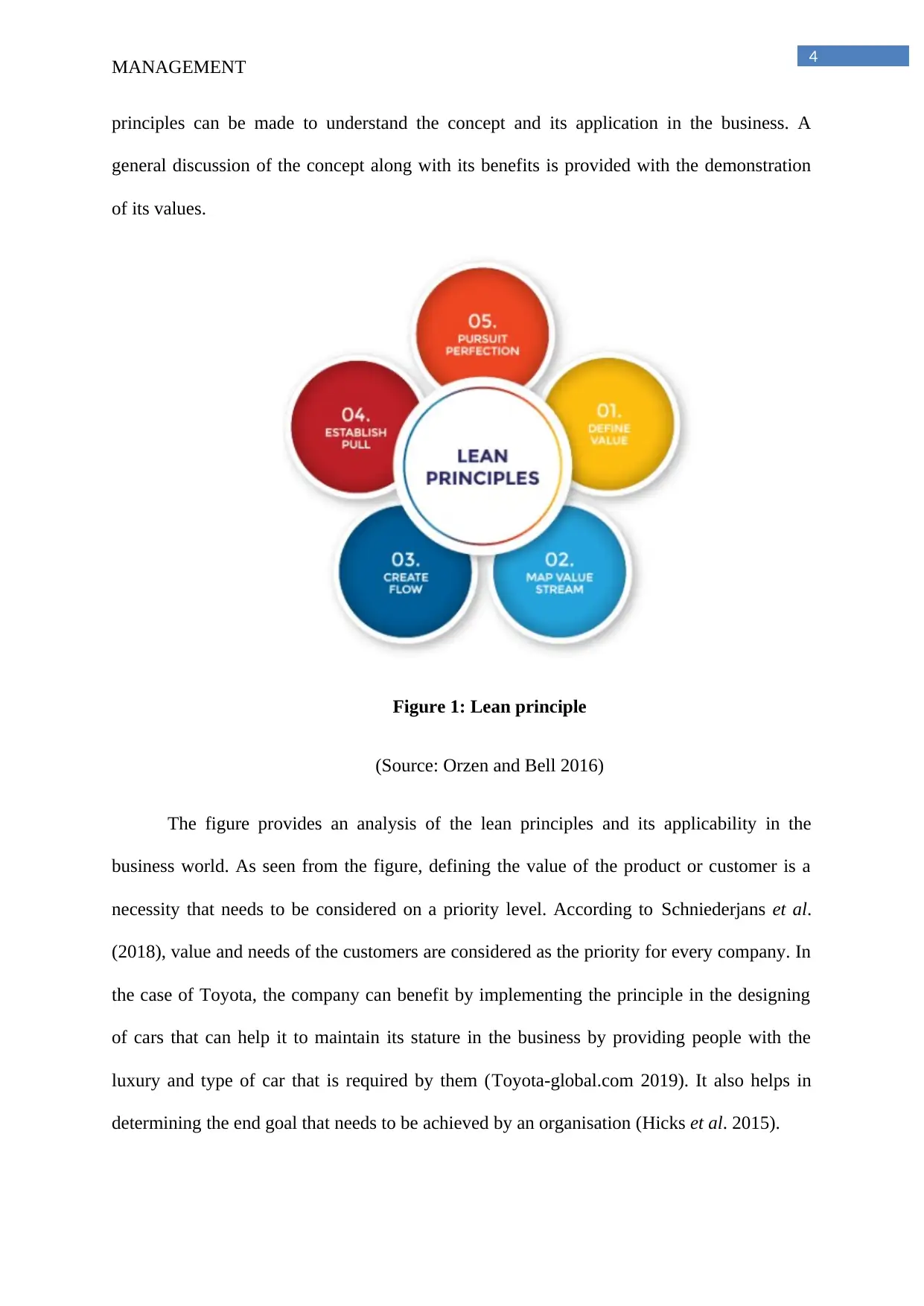
4
MANAGEMENT
principles can be made to understand the concept and its application in the business. A
general discussion of the concept along with its benefits is provided with the demonstration
of its values.
Figure 1: Lean principle
(Source: Orzen and Bell 2016)
The figure provides an analysis of the lean principles and its applicability in the
business world. As seen from the figure, defining the value of the product or customer is a
necessity that needs to be considered on a priority level. According to Schniederjans et al.
(2018), value and needs of the customers are considered as the priority for every company. In
the case of Toyota, the company can benefit by implementing the principle in the designing
of cars that can help it to maintain its stature in the business by providing people with the
luxury and type of car that is required by them (Toyota-global.com 2019). It also helps in
determining the end goal that needs to be achieved by an organisation (Hicks et al. 2015).
MANAGEMENT
principles can be made to understand the concept and its application in the business. A
general discussion of the concept along with its benefits is provided with the demonstration
of its values.
Figure 1: Lean principle
(Source: Orzen and Bell 2016)
The figure provides an analysis of the lean principles and its applicability in the
business world. As seen from the figure, defining the value of the product or customer is a
necessity that needs to be considered on a priority level. According to Schniederjans et al.
(2018), value and needs of the customers are considered as the priority for every company. In
the case of Toyota, the company can benefit by implementing the principle in the designing
of cars that can help it to maintain its stature in the business by providing people with the
luxury and type of car that is required by them (Toyota-global.com 2019). It also helps in
determining the end goal that needs to be achieved by an organisation (Hicks et al. 2015).
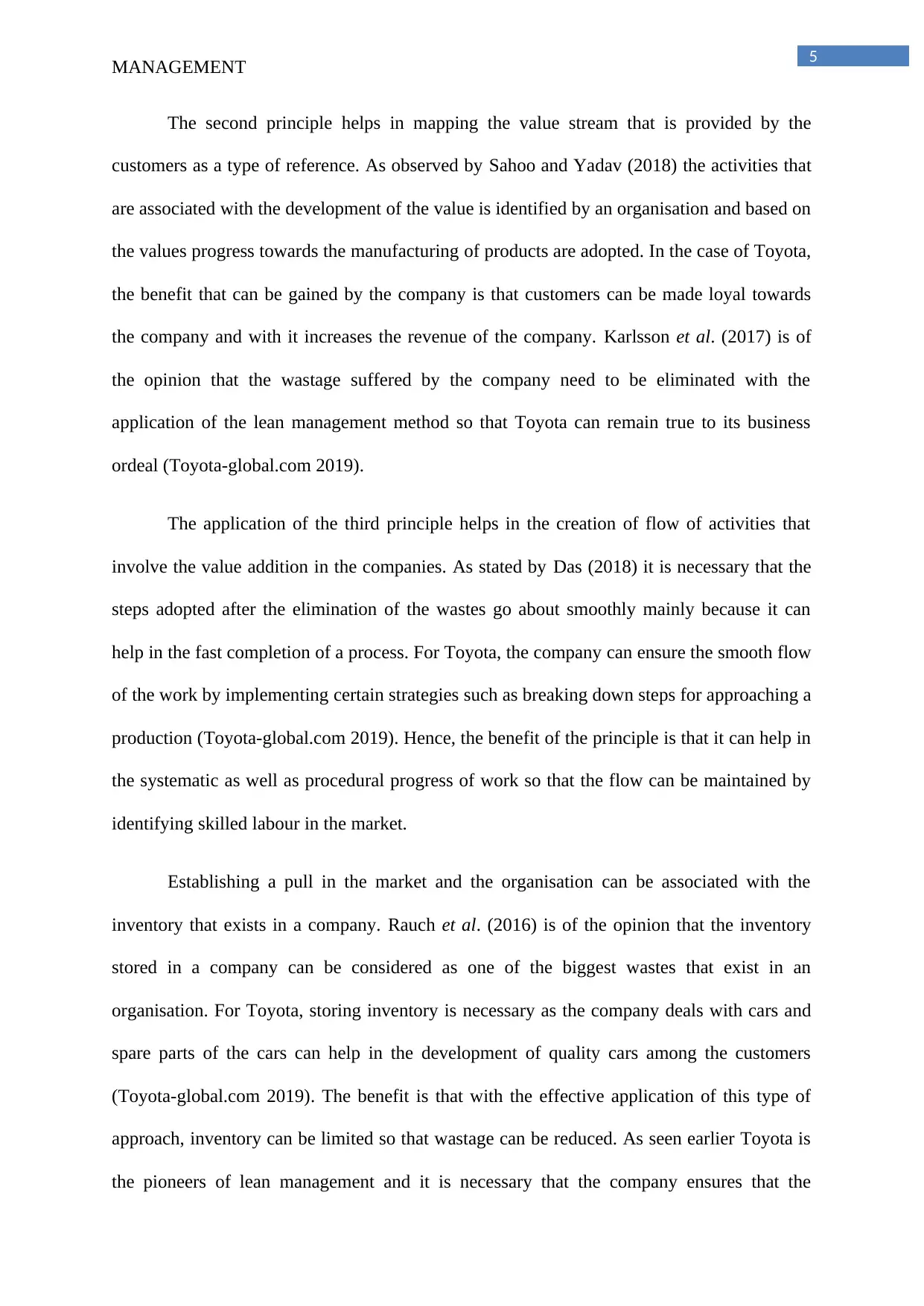
5
MANAGEMENT
The second principle helps in mapping the value stream that is provided by the
customers as a type of reference. As observed by Sahoo and Yadav (2018) the activities that
are associated with the development of the value is identified by an organisation and based on
the values progress towards the manufacturing of products are adopted. In the case of Toyota,
the benefit that can be gained by the company is that customers can be made loyal towards
the company and with it increases the revenue of the company. Karlsson et al. (2017) is of
the opinion that the wastage suffered by the company need to be eliminated with the
application of the lean management method so that Toyota can remain true to its business
ordeal (Toyota-global.com 2019).
The application of the third principle helps in the creation of flow of activities that
involve the value addition in the companies. As stated by Das (2018) it is necessary that the
steps adopted after the elimination of the wastes go about smoothly mainly because it can
help in the fast completion of a process. For Toyota, the company can ensure the smooth flow
of the work by implementing certain strategies such as breaking down steps for approaching a
production (Toyota-global.com 2019). Hence, the benefit of the principle is that it can help in
the systematic as well as procedural progress of work so that the flow can be maintained by
identifying skilled labour in the market.
Establishing a pull in the market and the organisation can be associated with the
inventory that exists in a company. Rauch et al. (2016) is of the opinion that the inventory
stored in a company can be considered as one of the biggest wastes that exist in an
organisation. For Toyota, storing inventory is necessary as the company deals with cars and
spare parts of the cars can help in the development of quality cars among the customers
(Toyota-global.com 2019). The benefit is that with the effective application of this type of
approach, inventory can be limited so that wastage can be reduced. As seen earlier Toyota is
the pioneers of lean management and it is necessary that the company ensures that the
MANAGEMENT
The second principle helps in mapping the value stream that is provided by the
customers as a type of reference. As observed by Sahoo and Yadav (2018) the activities that
are associated with the development of the value is identified by an organisation and based on
the values progress towards the manufacturing of products are adopted. In the case of Toyota,
the benefit that can be gained by the company is that customers can be made loyal towards
the company and with it increases the revenue of the company. Karlsson et al. (2017) is of
the opinion that the wastage suffered by the company need to be eliminated with the
application of the lean management method so that Toyota can remain true to its business
ordeal (Toyota-global.com 2019).
The application of the third principle helps in the creation of flow of activities that
involve the value addition in the companies. As stated by Das (2018) it is necessary that the
steps adopted after the elimination of the wastes go about smoothly mainly because it can
help in the fast completion of a process. For Toyota, the company can ensure the smooth flow
of the work by implementing certain strategies such as breaking down steps for approaching a
production (Toyota-global.com 2019). Hence, the benefit of the principle is that it can help in
the systematic as well as procedural progress of work so that the flow can be maintained by
identifying skilled labour in the market.
Establishing a pull in the market and the organisation can be associated with the
inventory that exists in a company. Rauch et al. (2016) is of the opinion that the inventory
stored in a company can be considered as one of the biggest wastes that exist in an
organisation. For Toyota, storing inventory is necessary as the company deals with cars and
spare parts of the cars can help in the development of quality cars among the customers
(Toyota-global.com 2019). The benefit is that with the effective application of this type of
approach, inventory can be limited so that wastage can be reduced. As seen earlier Toyota is
the pioneers of lean management and it is necessary that the company ensures that the
⊘ This is a preview!⊘
Do you want full access?
Subscribe today to unlock all pages.

Trusted by 1+ million students worldwide
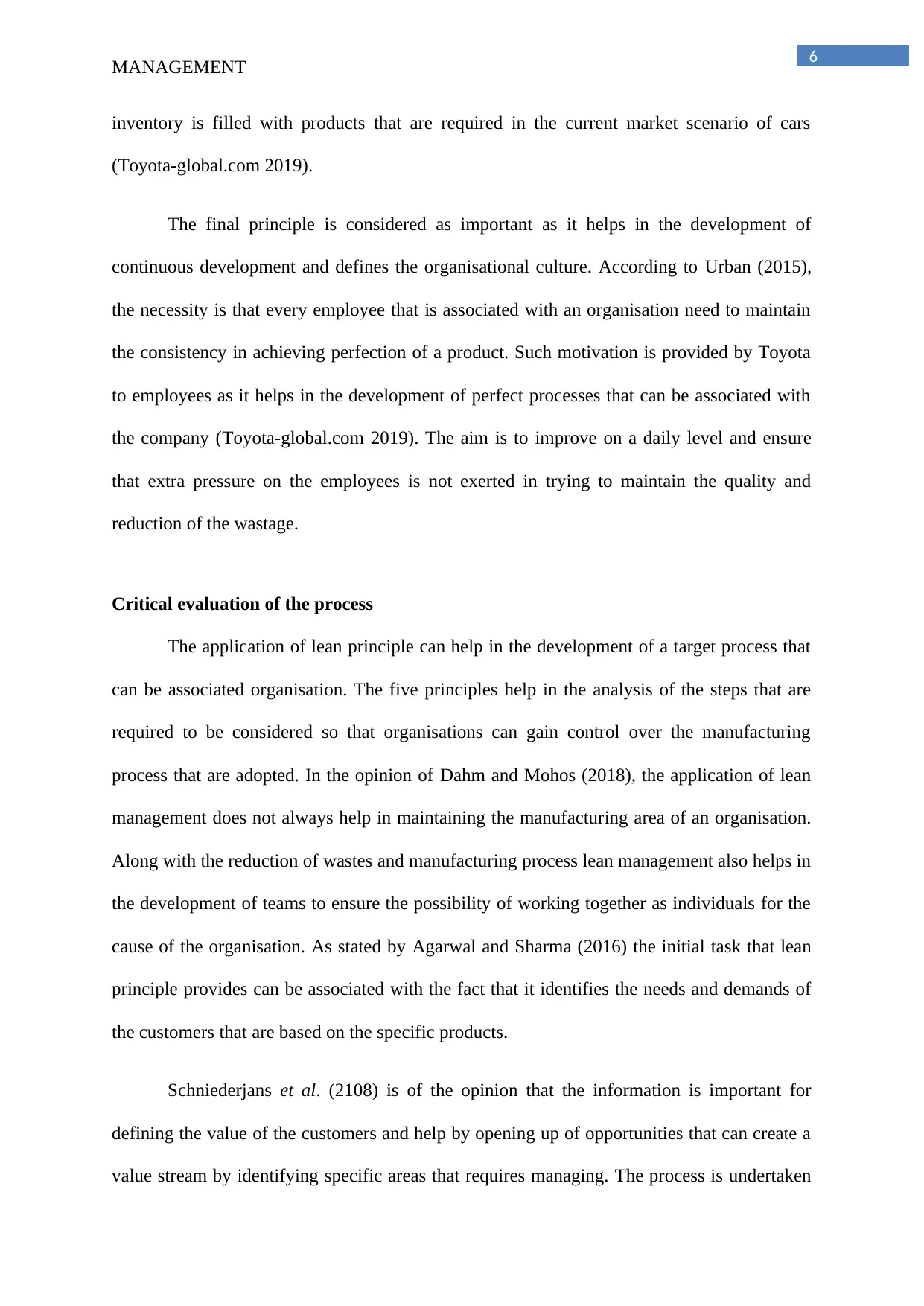
6
MANAGEMENT
inventory is filled with products that are required in the current market scenario of cars
(Toyota-global.com 2019).
The final principle is considered as important as it helps in the development of
continuous development and defines the organisational culture. According to Urban (2015),
the necessity is that every employee that is associated with an organisation need to maintain
the consistency in achieving perfection of a product. Such motivation is provided by Toyota
to employees as it helps in the development of perfect processes that can be associated with
the company (Toyota-global.com 2019). The aim is to improve on a daily level and ensure
that extra pressure on the employees is not exerted in trying to maintain the quality and
reduction of the wastage.
Critical evaluation of the process
The application of lean principle can help in the development of a target process that
can be associated organisation. The five principles help in the analysis of the steps that are
required to be considered so that organisations can gain control over the manufacturing
process that are adopted. In the opinion of Dahm and Mohos (2018), the application of lean
management does not always help in maintaining the manufacturing area of an organisation.
Along with the reduction of wastes and manufacturing process lean management also helps in
the development of teams to ensure the possibility of working together as individuals for the
cause of the organisation. As stated by Agarwal and Sharma (2016) the initial task that lean
principle provides can be associated with the fact that it identifies the needs and demands of
the customers that are based on the specific products.
Schniederjans et al. (2108) is of the opinion that the information is important for
defining the value of the customers and help by opening up of opportunities that can create a
value stream by identifying specific areas that requires managing. The process is undertaken
MANAGEMENT
inventory is filled with products that are required in the current market scenario of cars
(Toyota-global.com 2019).
The final principle is considered as important as it helps in the development of
continuous development and defines the organisational culture. According to Urban (2015),
the necessity is that every employee that is associated with an organisation need to maintain
the consistency in achieving perfection of a product. Such motivation is provided by Toyota
to employees as it helps in the development of perfect processes that can be associated with
the company (Toyota-global.com 2019). The aim is to improve on a daily level and ensure
that extra pressure on the employees is not exerted in trying to maintain the quality and
reduction of the wastage.
Critical evaluation of the process
The application of lean principle can help in the development of a target process that
can be associated organisation. The five principles help in the analysis of the steps that are
required to be considered so that organisations can gain control over the manufacturing
process that are adopted. In the opinion of Dahm and Mohos (2018), the application of lean
management does not always help in maintaining the manufacturing area of an organisation.
Along with the reduction of wastes and manufacturing process lean management also helps in
the development of teams to ensure the possibility of working together as individuals for the
cause of the organisation. As stated by Agarwal and Sharma (2016) the initial task that lean
principle provides can be associated with the fact that it identifies the needs and demands of
the customers that are based on the specific products.
Schniederjans et al. (2108) is of the opinion that the information is important for
defining the value of the customers and help by opening up of opportunities that can create a
value stream by identifying specific areas that requires managing. The process is undertaken
Paraphrase This Document
Need a fresh take? Get an instant paraphrase of this document with our AI Paraphraser
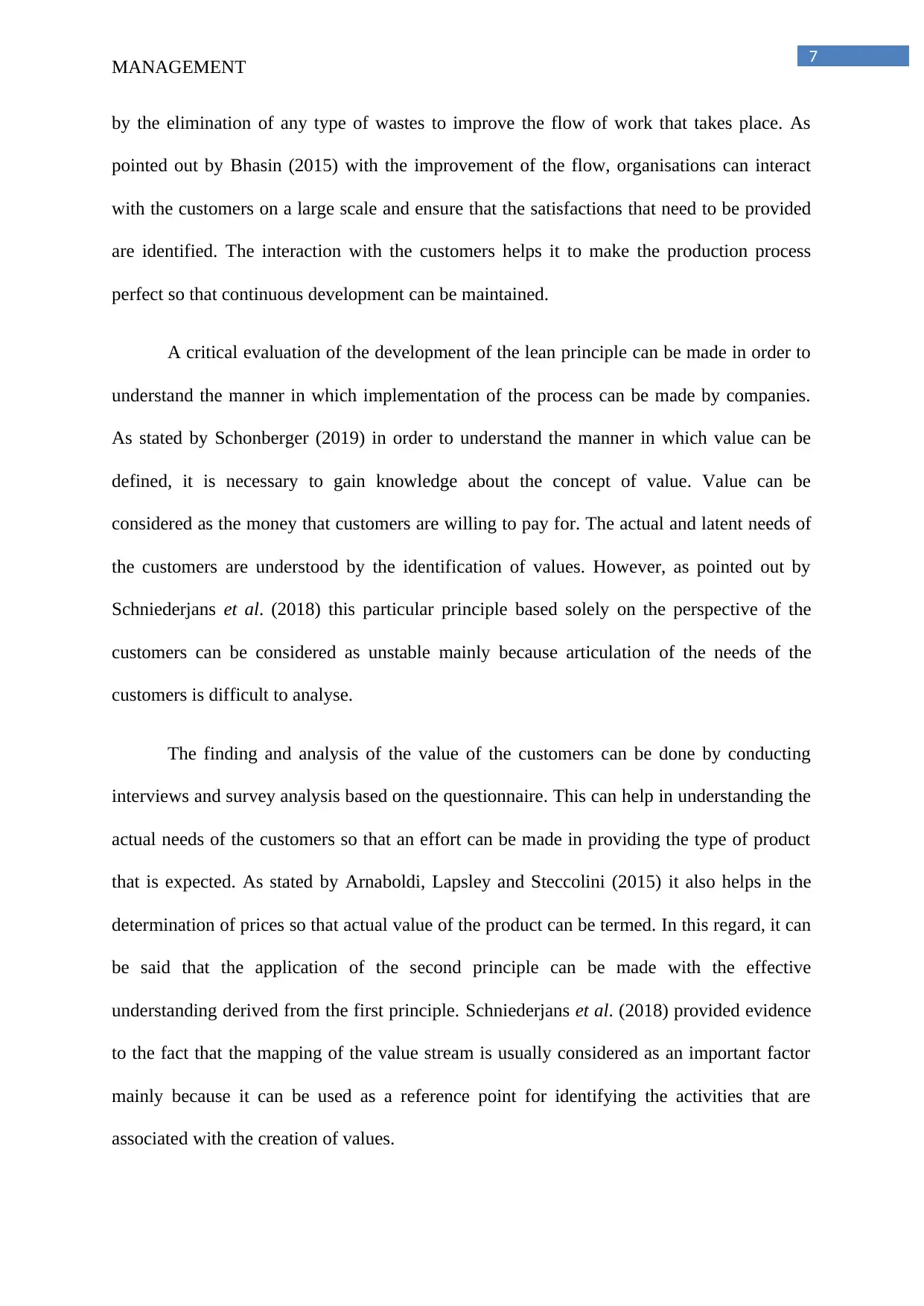
7
MANAGEMENT
by the elimination of any type of wastes to improve the flow of work that takes place. As
pointed out by Bhasin (2015) with the improvement of the flow, organisations can interact
with the customers on a large scale and ensure that the satisfactions that need to be provided
are identified. The interaction with the customers helps it to make the production process
perfect so that continuous development can be maintained.
A critical evaluation of the development of the lean principle can be made in order to
understand the manner in which implementation of the process can be made by companies.
As stated by Schonberger (2019) in order to understand the manner in which value can be
defined, it is necessary to gain knowledge about the concept of value. Value can be
considered as the money that customers are willing to pay for. The actual and latent needs of
the customers are understood by the identification of values. However, as pointed out by
Schniederjans et al. (2018) this particular principle based solely on the perspective of the
customers can be considered as unstable mainly because articulation of the needs of the
customers is difficult to analyse.
The finding and analysis of the value of the customers can be done by conducting
interviews and survey analysis based on the questionnaire. This can help in understanding the
actual needs of the customers so that an effort can be made in providing the type of product
that is expected. As stated by Arnaboldi, Lapsley and Steccolini (2015) it also helps in the
determination of prices so that actual value of the product can be termed. In this regard, it can
be said that the application of the second principle can be made with the effective
understanding derived from the first principle. Schniederjans et al. (2018) provided evidence
to the fact that the mapping of the value stream is usually considered as an important factor
mainly because it can be used as a reference point for identifying the activities that are
associated with the creation of values.
MANAGEMENT
by the elimination of any type of wastes to improve the flow of work that takes place. As
pointed out by Bhasin (2015) with the improvement of the flow, organisations can interact
with the customers on a large scale and ensure that the satisfactions that need to be provided
are identified. The interaction with the customers helps it to make the production process
perfect so that continuous development can be maintained.
A critical evaluation of the development of the lean principle can be made in order to
understand the manner in which implementation of the process can be made by companies.
As stated by Schonberger (2019) in order to understand the manner in which value can be
defined, it is necessary to gain knowledge about the concept of value. Value can be
considered as the money that customers are willing to pay for. The actual and latent needs of
the customers are understood by the identification of values. However, as pointed out by
Schniederjans et al. (2018) this particular principle based solely on the perspective of the
customers can be considered as unstable mainly because articulation of the needs of the
customers is difficult to analyse.
The finding and analysis of the value of the customers can be done by conducting
interviews and survey analysis based on the questionnaire. This can help in understanding the
actual needs of the customers so that an effort can be made in providing the type of product
that is expected. As stated by Arnaboldi, Lapsley and Steccolini (2015) it also helps in the
determination of prices so that actual value of the product can be termed. In this regard, it can
be said that the application of the second principle can be made with the effective
understanding derived from the first principle. Schniederjans et al. (2018) provided evidence
to the fact that the mapping of the value stream is usually considered as an important factor
mainly because it can be used as a reference point for identifying the activities that are
associated with the creation of values.
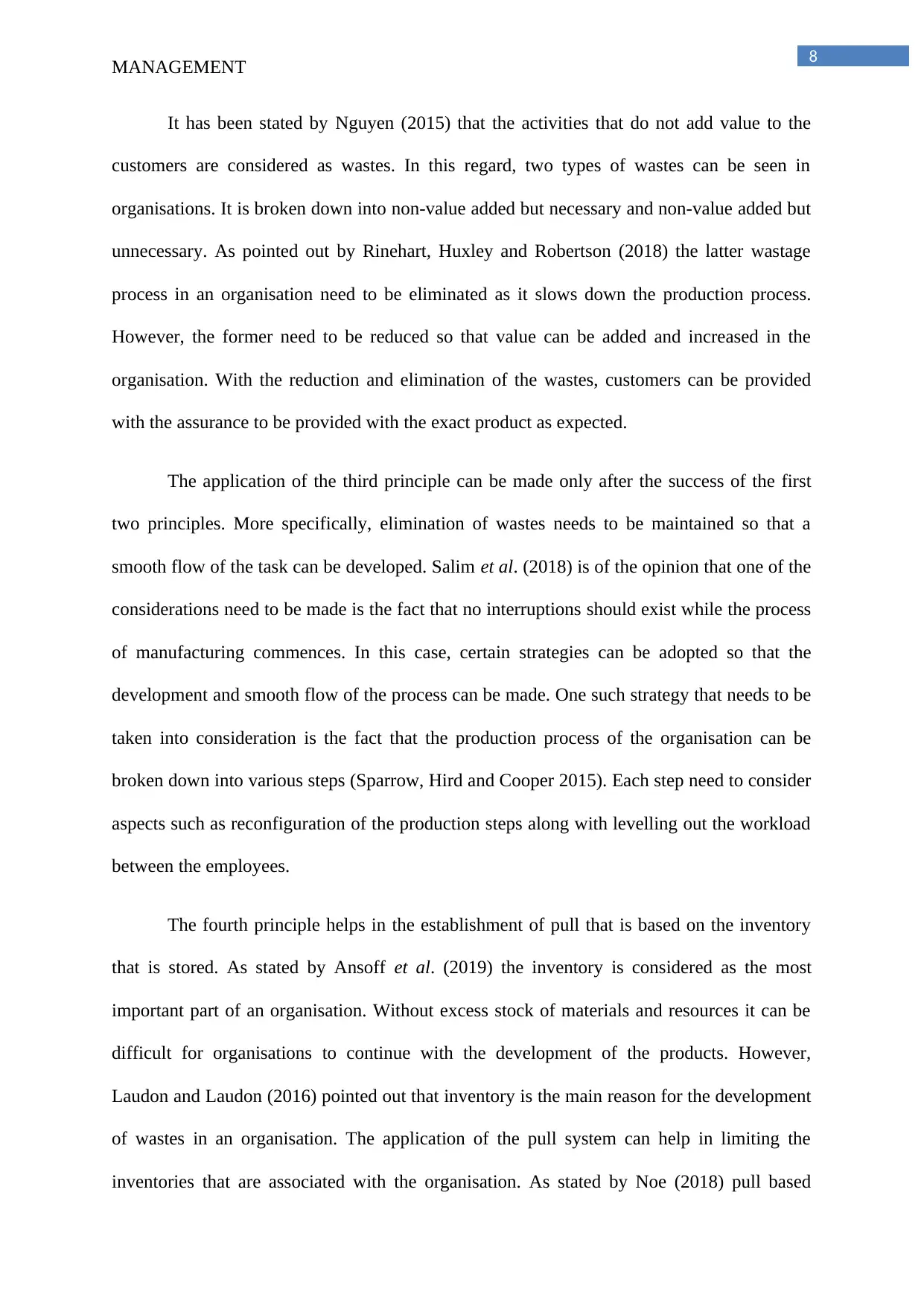
8
MANAGEMENT
It has been stated by Nguyen (2015) that the activities that do not add value to the
customers are considered as wastes. In this regard, two types of wastes can be seen in
organisations. It is broken down into non-value added but necessary and non-value added but
unnecessary. As pointed out by Rinehart, Huxley and Robertson (2018) the latter wastage
process in an organisation need to be eliminated as it slows down the production process.
However, the former need to be reduced so that value can be added and increased in the
organisation. With the reduction and elimination of the wastes, customers can be provided
with the assurance to be provided with the exact product as expected.
The application of the third principle can be made only after the success of the first
two principles. More specifically, elimination of wastes needs to be maintained so that a
smooth flow of the task can be developed. Salim et al. (2018) is of the opinion that one of the
considerations need to be made is the fact that no interruptions should exist while the process
of manufacturing commences. In this case, certain strategies can be adopted so that the
development and smooth flow of the process can be made. One such strategy that needs to be
taken into consideration is the fact that the production process of the organisation can be
broken down into various steps (Sparrow, Hird and Cooper 2015). Each step need to consider
aspects such as reconfiguration of the production steps along with levelling out the workload
between the employees.
The fourth principle helps in the establishment of pull that is based on the inventory
that is stored. As stated by Ansoff et al. (2019) the inventory is considered as the most
important part of an organisation. Without excess stock of materials and resources it can be
difficult for organisations to continue with the development of the products. However,
Laudon and Laudon (2016) pointed out that inventory is the main reason for the development
of wastes in an organisation. The application of the pull system can help in limiting the
inventories that are associated with the organisation. As stated by Noe (2018) pull based
MANAGEMENT
It has been stated by Nguyen (2015) that the activities that do not add value to the
customers are considered as wastes. In this regard, two types of wastes can be seen in
organisations. It is broken down into non-value added but necessary and non-value added but
unnecessary. As pointed out by Rinehart, Huxley and Robertson (2018) the latter wastage
process in an organisation need to be eliminated as it slows down the production process.
However, the former need to be reduced so that value can be added and increased in the
organisation. With the reduction and elimination of the wastes, customers can be provided
with the assurance to be provided with the exact product as expected.
The application of the third principle can be made only after the success of the first
two principles. More specifically, elimination of wastes needs to be maintained so that a
smooth flow of the task can be developed. Salim et al. (2018) is of the opinion that one of the
considerations need to be made is the fact that no interruptions should exist while the process
of manufacturing commences. In this case, certain strategies can be adopted so that the
development and smooth flow of the process can be made. One such strategy that needs to be
taken into consideration is the fact that the production process of the organisation can be
broken down into various steps (Sparrow, Hird and Cooper 2015). Each step need to consider
aspects such as reconfiguration of the production steps along with levelling out the workload
between the employees.
The fourth principle helps in the establishment of pull that is based on the inventory
that is stored. As stated by Ansoff et al. (2019) the inventory is considered as the most
important part of an organisation. Without excess stock of materials and resources it can be
difficult for organisations to continue with the development of the products. However,
Laudon and Laudon (2016) pointed out that inventory is the main reason for the development
of wastes in an organisation. The application of the pull system can help in limiting the
inventories that are associated with the organisation. As stated by Noe (2018) pull based
⊘ This is a preview!⊘
Do you want full access?
Subscribe today to unlock all pages.

Trusted by 1+ million students worldwide
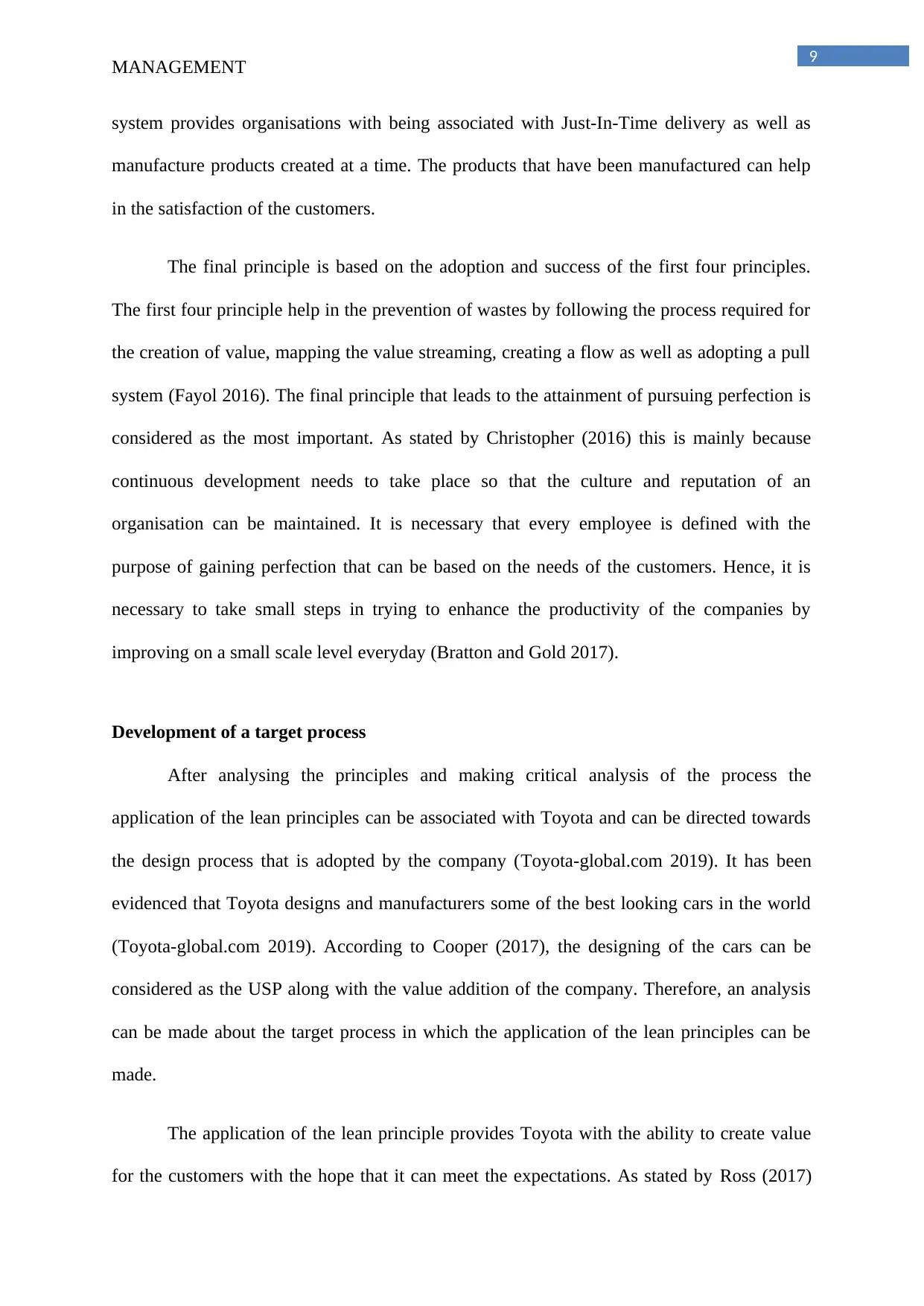
9
MANAGEMENT
system provides organisations with being associated with Just-In-Time delivery as well as
manufacture products created at a time. The products that have been manufactured can help
in the satisfaction of the customers.
The final principle is based on the adoption and success of the first four principles.
The first four principle help in the prevention of wastes by following the process required for
the creation of value, mapping the value streaming, creating a flow as well as adopting a pull
system (Fayol 2016). The final principle that leads to the attainment of pursuing perfection is
considered as the most important. As stated by Christopher (2016) this is mainly because
continuous development needs to take place so that the culture and reputation of an
organisation can be maintained. It is necessary that every employee is defined with the
purpose of gaining perfection that can be based on the needs of the customers. Hence, it is
necessary to take small steps in trying to enhance the productivity of the companies by
improving on a small scale level everyday (Bratton and Gold 2017).
Development of a target process
After analysing the principles and making critical analysis of the process the
application of the lean principles can be associated with Toyota and can be directed towards
the design process that is adopted by the company (Toyota-global.com 2019). It has been
evidenced that Toyota designs and manufacturers some of the best looking cars in the world
(Toyota-global.com 2019). According to Cooper (2017), the designing of the cars can be
considered as the USP along with the value addition of the company. Therefore, an analysis
can be made about the target process in which the application of the lean principles can be
made.
The application of the lean principle provides Toyota with the ability to create value
for the customers with the hope that it can meet the expectations. As stated by Ross (2017)
MANAGEMENT
system provides organisations with being associated with Just-In-Time delivery as well as
manufacture products created at a time. The products that have been manufactured can help
in the satisfaction of the customers.
The final principle is based on the adoption and success of the first four principles.
The first four principle help in the prevention of wastes by following the process required for
the creation of value, mapping the value streaming, creating a flow as well as adopting a pull
system (Fayol 2016). The final principle that leads to the attainment of pursuing perfection is
considered as the most important. As stated by Christopher (2016) this is mainly because
continuous development needs to take place so that the culture and reputation of an
organisation can be maintained. It is necessary that every employee is defined with the
purpose of gaining perfection that can be based on the needs of the customers. Hence, it is
necessary to take small steps in trying to enhance the productivity of the companies by
improving on a small scale level everyday (Bratton and Gold 2017).
Development of a target process
After analysing the principles and making critical analysis of the process the
application of the lean principles can be associated with Toyota and can be directed towards
the design process that is adopted by the company (Toyota-global.com 2019). It has been
evidenced that Toyota designs and manufacturers some of the best looking cars in the world
(Toyota-global.com 2019). According to Cooper (2017), the designing of the cars can be
considered as the USP along with the value addition of the company. Therefore, an analysis
can be made about the target process in which the application of the lean principles can be
made.
The application of the lean principle provides Toyota with the ability to create value
for the customers with the hope that it can meet the expectations. As stated by Ross (2017)
Paraphrase This Document
Need a fresh take? Get an instant paraphrase of this document with our AI Paraphraser
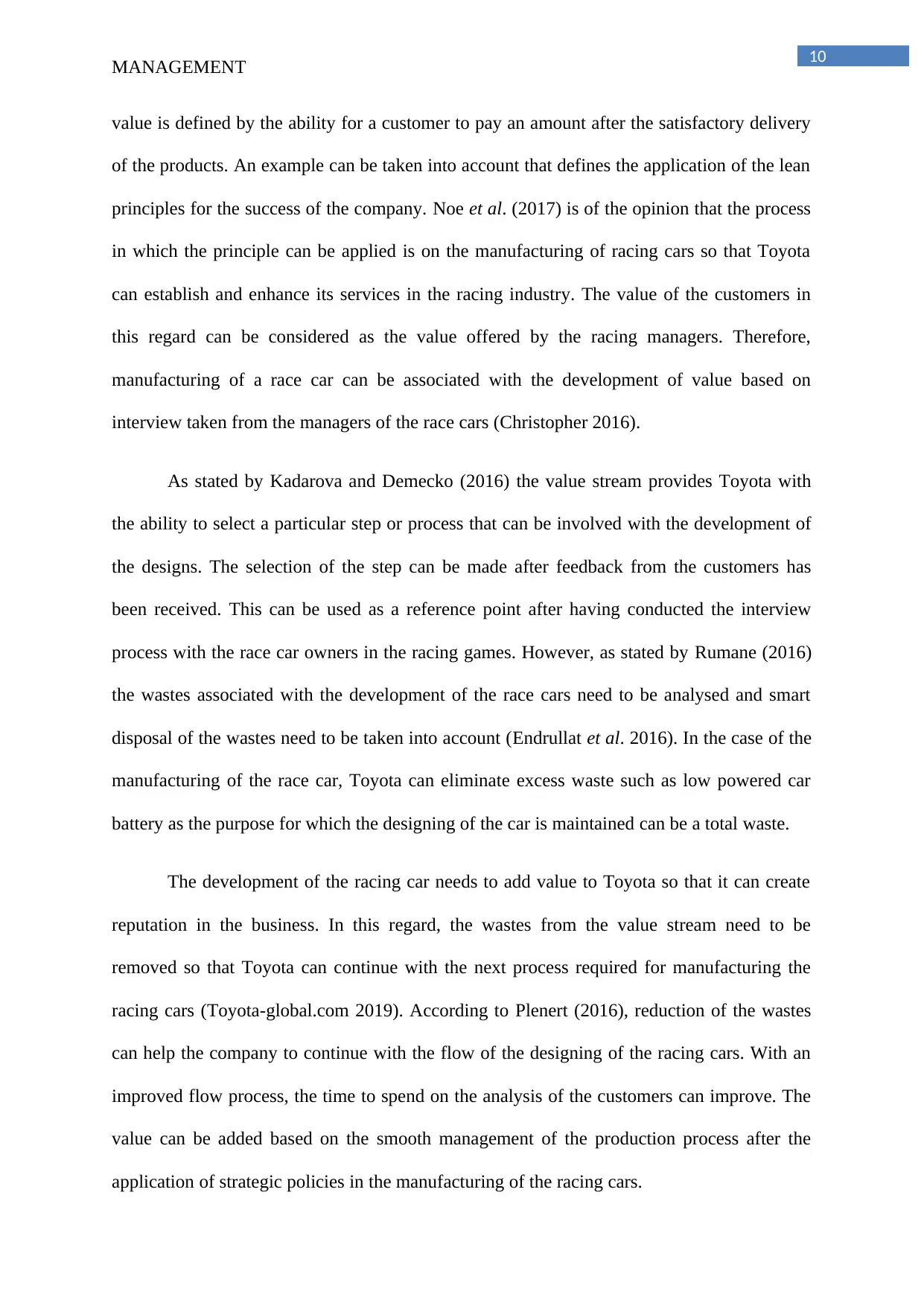
10
MANAGEMENT
value is defined by the ability for a customer to pay an amount after the satisfactory delivery
of the products. An example can be taken into account that defines the application of the lean
principles for the success of the company. Noe et al. (2017) is of the opinion that the process
in which the principle can be applied is on the manufacturing of racing cars so that Toyota
can establish and enhance its services in the racing industry. The value of the customers in
this regard can be considered as the value offered by the racing managers. Therefore,
manufacturing of a race car can be associated with the development of value based on
interview taken from the managers of the race cars (Christopher 2016).
As stated by Kadarova and Demecko (2016) the value stream provides Toyota with
the ability to select a particular step or process that can be involved with the development of
the designs. The selection of the step can be made after feedback from the customers has
been received. This can be used as a reference point after having conducted the interview
process with the race car owners in the racing games. However, as stated by Rumane (2016)
the wastes associated with the development of the race cars need to be analysed and smart
disposal of the wastes need to be taken into account (Endrullat et al. 2016). In the case of the
manufacturing of the race car, Toyota can eliminate excess waste such as low powered car
battery as the purpose for which the designing of the car is maintained can be a total waste.
The development of the racing car needs to add value to Toyota so that it can create
reputation in the business. In this regard, the wastes from the value stream need to be
removed so that Toyota can continue with the next process required for manufacturing the
racing cars (Toyota-global.com 2019). According to Plenert (2016), reduction of the wastes
can help the company to continue with the flow of the designing of the racing cars. With an
improved flow process, the time to spend on the analysis of the customers can improve. The
value can be added based on the smooth management of the production process after the
application of strategic policies in the manufacturing of the racing cars.
MANAGEMENT
value is defined by the ability for a customer to pay an amount after the satisfactory delivery
of the products. An example can be taken into account that defines the application of the lean
principles for the success of the company. Noe et al. (2017) is of the opinion that the process
in which the principle can be applied is on the manufacturing of racing cars so that Toyota
can establish and enhance its services in the racing industry. The value of the customers in
this regard can be considered as the value offered by the racing managers. Therefore,
manufacturing of a race car can be associated with the development of value based on
interview taken from the managers of the race cars (Christopher 2016).
As stated by Kadarova and Demecko (2016) the value stream provides Toyota with
the ability to select a particular step or process that can be involved with the development of
the designs. The selection of the step can be made after feedback from the customers has
been received. This can be used as a reference point after having conducted the interview
process with the race car owners in the racing games. However, as stated by Rumane (2016)
the wastes associated with the development of the race cars need to be analysed and smart
disposal of the wastes need to be taken into account (Endrullat et al. 2016). In the case of the
manufacturing of the race car, Toyota can eliminate excess waste such as low powered car
battery as the purpose for which the designing of the car is maintained can be a total waste.
The development of the racing car needs to add value to Toyota so that it can create
reputation in the business. In this regard, the wastes from the value stream need to be
removed so that Toyota can continue with the next process required for manufacturing the
racing cars (Toyota-global.com 2019). According to Plenert (2016), reduction of the wastes
can help the company to continue with the flow of the designing of the racing cars. With an
improved flow process, the time to spend on the analysis of the customers can improve. The
value can be added based on the smooth management of the production process after the
application of strategic policies in the manufacturing of the racing cars.
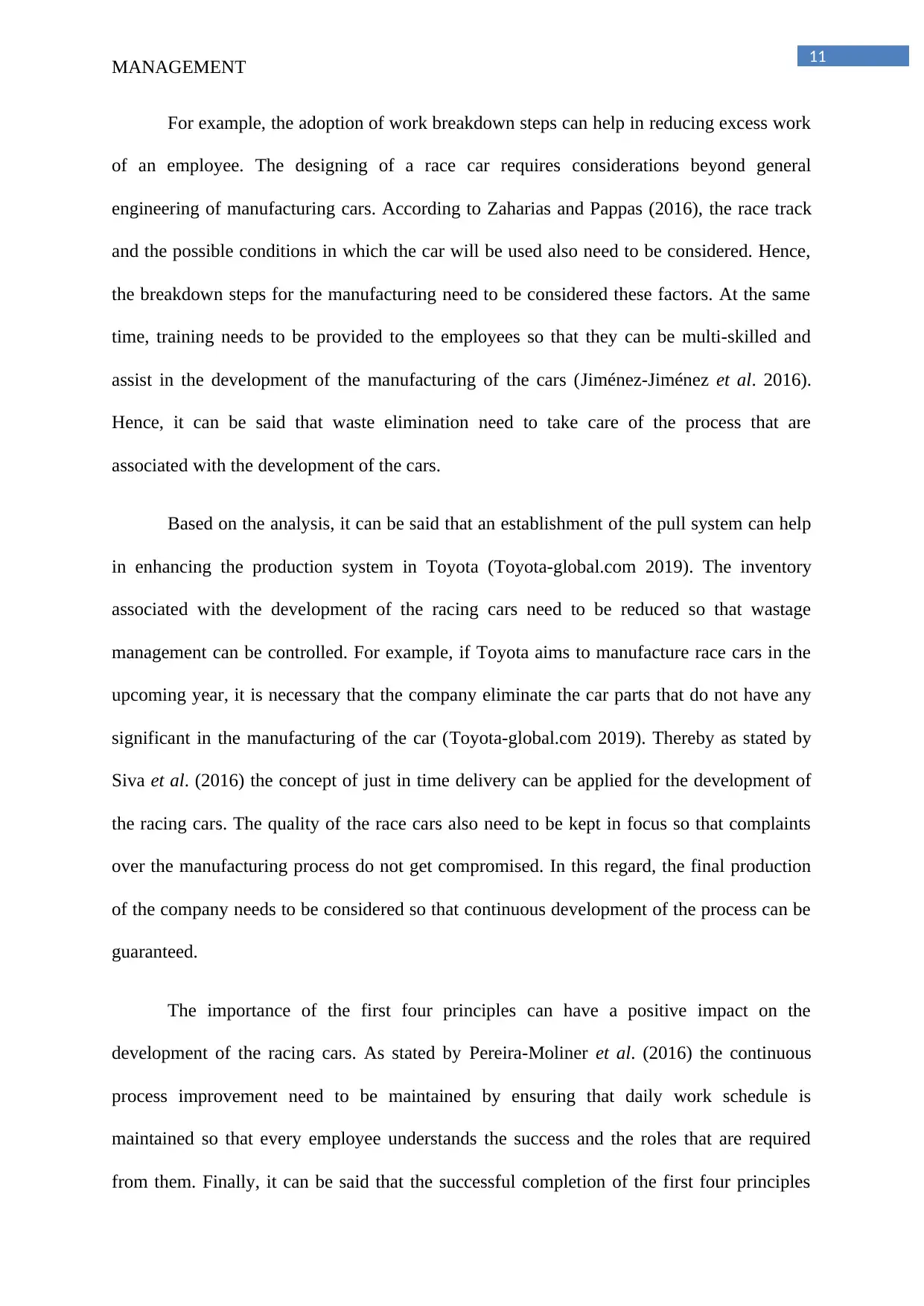
11
MANAGEMENT
For example, the adoption of work breakdown steps can help in reducing excess work
of an employee. The designing of a race car requires considerations beyond general
engineering of manufacturing cars. According to Zaharias and Pappas (2016), the race track
and the possible conditions in which the car will be used also need to be considered. Hence,
the breakdown steps for the manufacturing need to be considered these factors. At the same
time, training needs to be provided to the employees so that they can be multi-skilled and
assist in the development of the manufacturing of the cars (Jiménez-Jiménez et al. 2016).
Hence, it can be said that waste elimination need to take care of the process that are
associated with the development of the cars.
Based on the analysis, it can be said that an establishment of the pull system can help
in enhancing the production system in Toyota (Toyota-global.com 2019). The inventory
associated with the development of the racing cars need to be reduced so that wastage
management can be controlled. For example, if Toyota aims to manufacture race cars in the
upcoming year, it is necessary that the company eliminate the car parts that do not have any
significant in the manufacturing of the car (Toyota-global.com 2019). Thereby as stated by
Siva et al. (2016) the concept of just in time delivery can be applied for the development of
the racing cars. The quality of the race cars also need to be kept in focus so that complaints
over the manufacturing process do not get compromised. In this regard, the final production
of the company needs to be considered so that continuous development of the process can be
guaranteed.
The importance of the first four principles can have a positive impact on the
development of the racing cars. As stated by Pereira-Moliner et al. (2016) the continuous
process improvement need to be maintained by ensuring that daily work schedule is
maintained so that every employee understands the success and the roles that are required
from them. Finally, it can be said that the successful completion of the first four principles
MANAGEMENT
For example, the adoption of work breakdown steps can help in reducing excess work
of an employee. The designing of a race car requires considerations beyond general
engineering of manufacturing cars. According to Zaharias and Pappas (2016), the race track
and the possible conditions in which the car will be used also need to be considered. Hence,
the breakdown steps for the manufacturing need to be considered these factors. At the same
time, training needs to be provided to the employees so that they can be multi-skilled and
assist in the development of the manufacturing of the cars (Jiménez-Jiménez et al. 2016).
Hence, it can be said that waste elimination need to take care of the process that are
associated with the development of the cars.
Based on the analysis, it can be said that an establishment of the pull system can help
in enhancing the production system in Toyota (Toyota-global.com 2019). The inventory
associated with the development of the racing cars need to be reduced so that wastage
management can be controlled. For example, if Toyota aims to manufacture race cars in the
upcoming year, it is necessary that the company eliminate the car parts that do not have any
significant in the manufacturing of the car (Toyota-global.com 2019). Thereby as stated by
Siva et al. (2016) the concept of just in time delivery can be applied for the development of
the racing cars. The quality of the race cars also need to be kept in focus so that complaints
over the manufacturing process do not get compromised. In this regard, the final production
of the company needs to be considered so that continuous development of the process can be
guaranteed.
The importance of the first four principles can have a positive impact on the
development of the racing cars. As stated by Pereira-Moliner et al. (2016) the continuous
process improvement need to be maintained by ensuring that daily work schedule is
maintained so that every employee understands the success and the roles that are required
from them. Finally, it can be said that the successful completion of the first four principles
⊘ This is a preview!⊘
Do you want full access?
Subscribe today to unlock all pages.

Trusted by 1+ million students worldwide
1 out of 23
Related Documents
Your All-in-One AI-Powered Toolkit for Academic Success.
+13062052269
info@desklib.com
Available 24*7 on WhatsApp / Email
![[object Object]](/_next/static/media/star-bottom.7253800d.svg)
Unlock your academic potential
Copyright © 2020–2025 A2Z Services. All Rights Reserved. Developed and managed by ZUCOL.





